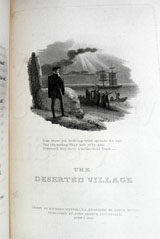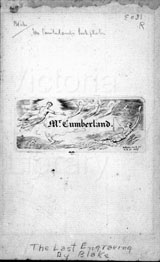While a source of sorrow to thousands, widespread emigration from Britain in the second half of the eighteenth century--a consequence of civil wars and economic hardship--also brought knowledge of other lands and ways of life. A matter of public debate for decades, emigration became a common theme in literature and art, Goldsmith’s Deserted Village of 1770 leading the way.
The engraving by Thomas Bewick shows the loss of three generations in “The Departure.”
Oliver Goldsmith.
“The Deserted Village.” Poems.
A reproduction of an engraving by Richard Westall from another edition of “The Deserted Village,” illustrating the lines, “Down where yon Anch’ring vessel spreads the sail,/ That idly waiting flaps with ev’ry gale/ Downward they move a melancholy band.”
Engraving by Richard Westall.
Oliver Goldsmith. Poetical Works.
London: Sherwood et al., 1816.
This manuscript play, a farce composed probably between 1800 and 1805, represents an unusual response to the problem of emigration. The characters include Ebenezer Sullen, an American ship’s captain; Ben, the ship’s cook, who is a free black man; Squire Acres, who is emigrating with his family and a cargo of merino sheep; and Major Dandy, “a Parasite” who will be travelling with them.
George Cumberland.
“The Emigrants or, A Trip to the Ohio.”








